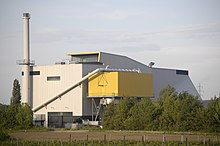Air-cooled condenser
An air-cooled condenser (short air condenser or Luko ) is a heat exchanger that is used for the condensation of fluids, whereby the condensation heat is transferred to an air flow.
Working principle
The vaporous medium is passed through finned tubes around which air flows. The air cools the pipe walls so that the steam can condense on them. The wall temperature and thus the air temperature must be below the condensation temperature of the steam. The condensation temperature of vapors includes a condensation pressure that is established in the vapor space of the condenser. Together with the temperature, it forms the condensation point . Water condenses at a pressure of 1 bar and a condensation temperature of 100 ° C.
In order to design an air condenser, the following parameters must be known:
- Location with air pressure, air humidity and air temperature
- Amount of steam
- Steam temperature
- desired condensation pressure
application
Air condensers are used in power plants to condense the exhaust steam after the steam turbine . The lower the achievable condensation pressure, the better the efficiency of the turbine. The condensation pressure or condensation temperature are limited by the ambient temperature, i.e. the medium cannot be cooled down further than the ambient air temperature. Air condensers are always used when there is not enough cooling water available. Air condensers are used in refrigeration systems to reliquefy the refrigerant (example: refrigerator ; see also condenser ).
construction
As a rule, air condensers consist of tube bundles through which the vaporous medium flows and a fan that ensures that ambient air flows around the tube bundle. With simple air condensers, there is no fan. Natural convection is then used to drive the air flow .
Since air has a low heat transfer coefficient , a large transfer surface is necessary on the air side in order to be able to dissipate the heat. That is why finned tubes are often used for air condensers. Air condensers are always significantly larger than liquid-cooled condensers of the same power.
Air condensers have higher condensation temperatures than evaporative condensers. Since in the second variant the enthalpy of evaporation of the injected water is also used, condensation temperatures below the air temperature are possible. Systems with evaporation condensers are therefore more efficient than systems with air condensers. The advantage of air condensers is that they are easier to maintain. There is no need to regulate, treat or condition the spray water. The ribbed heat exchanger surfaces must, however, be cleaned regularly, since dust and organic particles are deposited on the exchange surfaces and impair the heat transfer. In larger power plants, cleaning systems with water spray nozzles are permanently installed, which are moved on a slide.
Power plants
The air condensers in power plants ( short: LuKo ) with condensation turbines work in the negative pressure, which corresponds to the saturated steam pressure at the condensation temperature. (Condensation temperature 35 ° C: condensation pressure: 0.05 bar (absolute)). Devices are required to extract disruptive air through small leaks or when starting up the steam boiler . Steam ejectors and / or water ring pumps are used for evacuation and air suction . The resulting condensate is collected in the condensate container and conveyed back into the feed water container by means of condensate pumps and can be used again in the power plant process.
Refrigeration
Air condensers in refrigeration systems are called condensers . Except for small systems (refrigerators), fans are always used to increase the air mass flow. In larger systems, speed-controlled fans are used, which are regulated via the condensation temperature.


